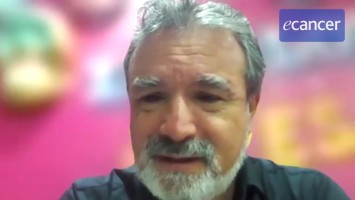I started my lectures at this meeting with two related talks on evidence-based approach to lymph nodes. Breast cancer metastasises really via the lymphatic system so studying the lymph nodes is really important for all aspects of breast imaging and breast cancer detection and care. It started with a review to know the basics, to know what we encounter every day, and then ended up by talking about some of our latest research in our group about the imaging evaluation of lymph nodes.
One particular area that is of recent interest is the differentiation between abnormal lymph nodes from breast cancer versus abnormal lymph nodes as a reaction to being vaccinated against COVID-19 which has become a worldwide question – what is cancer and what is not? So it was interesting to look at our population and say, hey, are there ultrasound features that you can use to distinguish the two? We found that there are some, in particular what we call cortical thickness – how abnormally enlarged is the node, just for example. We had a cut-off parameter of 5.4mm. So that is fairly topical.
In terms of lymph nodes, the research was also based on how tumours spread and a relatively new concept is that tumours can spread in a discontinuous pattern, so it’s not necessarily orderly. So the discontinuous is what we call skip metastases and that may affect how we have imaging protocols on our patients. Then also looking at different histologies of breast cancer, what we call ductal versus what we call lobular and how they may appear different when they spread to the lymph nodes. So that’s essentially the lymph node discussion, if you will.
I hope that the conclusions and the lessons can also be applicable here in Egypt, the Middle East, and around the world. I hope that it was fun and enjoyable for the audience.
I then concluded with a discussion on basically cases and I chose to concentrate on three different areas, being the following three: number one, what we call targeted axillary dissection, so a new way of looking at the lymph nodes to get a lot of information but not doing so much that you get complications from axillary surgery. Number two is a change in how we treat patients who have really, really good response to therapy, to medicine that is given before surgery. So the idea is that in these individuals what we call neoadjuvant systemic therapy, if they do really well they may not need surgery. And that’s what we call a paradigm shift because standard of care is to have surgery. Data is early and is preliminary but is promising. I talked about the latest paper which was just published in December 2022, so that’s hot off the press, showing really promising results in that light. Then I talked a little bit of a benign use of our technology, MRI in particular, in the setting of not cancer, benign disease. Of course, that’s also important because many women have findings, lesions, clinical symptoms that are not cancer. So to make sure that’s not cancer, reassurance, to say it’s okay, I believe that’s also a very valuable and very meaningful part of our job as breast radiologists and breast doctors.








